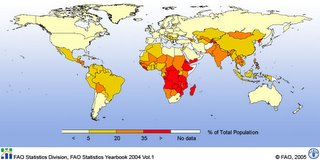The number of hectares of farm land used to grow genetically modified plants grew by 11% in 2005. That's an increase from 200 million acres in 2004 to 222 million acres planted in 2005, 60% of that cropland were planted with herbicide tolerant soybeans.

The continued adoption of biotech crops in industrialized countries is not surprising and, frankly, means very little to me except that farmers continue to view biotech seeds as a good investment. There is little chance for the "escape" of transgenes for herbicide tolerance in Soy in a country like the US, or in most other areas of the world. However, the adoption of biotech crops in developing countries is a much more interesting phenomenon to me. Particularly in those countries where a significant portion of the population is suffering from undernourishment.

The map above (click to enlarge) shows the percent of total population that suffers from undernourishment. The map below shows countries who are major adopters of biotech crops:

Some "advanced" countries like the US, Canada, Australia, and Western Europe are major adopters of transgenic plant technology who have only small problems with undernourishment in their countries. The farmers in these countries are using biotech crops because they can make a profit by reducing losses to crop pests, or by eliminating weeds in fields that compete with crops for nutrients, water, and light. Countries like China and India suffer from major problems with undernourishment in their populations. In these two countries, the first and second most populous countries in the world, the promise of biotechnology is not an additional few cents per hectare of profit for farmers, it represents an increase in the amount of food people have to eat. With the population of India expected to reach 1.6 billion by 2050 and China's expected to reach 1.4 billion, the use of biotech crops in these countries is not an option, it is a necessity. There is land of poor quality in these countries that can be converted to farm land but this land will not be as productive as the best crop land that is currently under cultivation there, and every new hectare of farmland represents a hectare of environment and habitat destruction. Even a modest shift in diet in these countries from plant based foods to meat will seriously reduce the amount of food available for the poorest individuals in these growing economies. To feed the growing populations in these countries and elsewhere in the world, there is no choice but to glean more food from the land that is currently available.
I very seriously doubt that genetically modified foods alone can produce the needed increases in food production in these countries. And I am certain that the needed increases in food production cannot be acheived without the use of genetically modified foods.
"The power of population is so superior to the power of the earth to produce subsistence for man, that premature death must in some shape or other visit the human race. The vices of mankind are active and able ministers of depopulation. They are the precursors in the great army of destruction; and often finish the dreadful work themselves. But should they fail in this war of extermination, sickly seasons, epidemics, pestilence, and plague, advance in terrific array, and sweep off their thousands and tens of thousands. Should success be still incomplete, gigantic inevitable famine stalks in the rear, and with one mighty blow levels the population with the food of the world." --Malthus
Malthus has been proven wrong in the past, I hope he can be proven wrong in the future.
The only blog inspired by a bumper sticker. |







 R|Mail
R|Mail





Comments on "Ten Years of Biotech Crops."
-
 Biowebspin Administrator said ... (6/07/2013 9:04 AM) :
Biowebspin Administrator said ... (6/07/2013 9:04 AM) :
post a commentWe have noticed that your article is related to Life Sciences matters and have been mentioned on Biowebspin, the Bio Dashboard for the largest netwok in Biotech, Pharma & Medtech. Here is the link :
http://www.biowebspin.com/members/cwang/activity/121411/
You can also post your abstract of your articles on Biowebspin Public Place (http://www.biowebspin.com/activity/) and be seen by thousands of Life Sciences visitors all across the globe.
Best Regards,
The Biowebspin’s team.